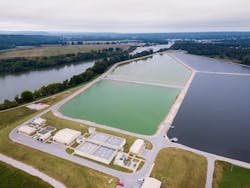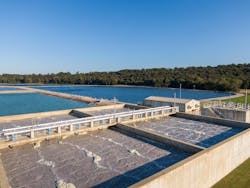Plant Profile: Batesville Wastewater Treatment Plant
About the author:
Carol Brzozowski is a freelance writer for Water & Wastes Digest. Brzozowski can be reached at [email protected].
Location: Batesville, Arkansas
Size: 4.2 average mgd; 9 mgd rated capacity
Equipment: Lagoon treatment, moving bed biofilm reactors, dissolved air flotation, fine bubble diffusion, mechanical skimmers, chlorination, flow measurement
A Moving Bed Biofilm Reactor (MBBR) that went online in Batesville, Arkansas in 2015 is exceeding expectations and has won several accolades.
More than 10 years ago, Batesville officials sought a new wastewater treatment system to replace its 30-year-old system that had reached maximum capacity and needed to meet new, strict effluent limits. Jim Ulmer, engineering technical leader at McGoodwin Williams and Yates, a division of Olsson, noted his firm knew Batesville’s system well, since it had helped the city years ago with wastewater treatment problems in the aftermath of a flood in the early 1980s that had taken out a portion of the plant.
Effluent Limit Complications
“About 2008, they were having a tremendous problem at their wastewater plant meeting their effluent limits,” Ulmer said. “It got to the point that the state issued a consent administrative order to solve the problem. We went to work on that problem with them.”
Many alternatives were considered, including building an advanced waste treatment plant.
“We started to zero in on the MBBR process and visited other places in the U.S. with it to talk to the operators,” Ulmer said. The system is commonly used in Europe.
Batesville city engineer Damon Johnson indicated the MBBR alternative offered more benefits than other options.
“With MBBR, the plant expansion could be done with minor disruptions to the existing treatment process. MBBR was the easiest to operate and maintain, it is easily expandable for future needs, it allowed the current lagoon cells to remain in use for treatment and flow equalization, and allowed the continuation of existing sludge storage/disposal methods,” Johnson noted.
The maximum capacity of the previous system – serving a population of 10,706 – was 4.2 million gallons per day (mgd) of treatment. The new plant is currently rated at 9 mgd per day.
That capacity more than meets current demand, Johnson noted, adding that as the community grows and expansion is required, the system can expand up to 10.4 mgd by adding additional media to existing MBBR basins.
“When expansion beyond 10.4 mgd is required, infrastructure is in place to build another MBBR train,” he added.
Batesville Treatment Process
The wastewater treatment process entails the MBBR system, lagoons, and a basin.
“The two treatment lagoons allow for solids to be settled out, and during the warmer months offer some CBOD and ammonia removal,” said Johnson. “After working through the first two lagoons, the wastewater is pumped from the second lagoon to the MBBRs. From this point, the water gravity flows through the remainder of the plant. The water enters the first MBBR basin where the CBOD is removed with naturally-occurring microbes and then the water flows into the second MBBR basin where ammonia is removed by different naturally-occurring microbes.”
At that point, the biological process is completed. The wastewater then flows into the dissolved air floatation (DAF) units where suspended solids are removed with fine air bubbles combined with mechanical skimmers.
For the final stage of treatment, the water flows through the chlorine contact chamber where chlorine is added to destroy any remaining fecal coliform bacteria. Then, the water flows through the effluent flume where the flow is measured as it is discharged to the White River.
“During cold weather the temperature in the lagoons drops significantly, which slows the microbiological process down so that it is ineffective,” Johnson said. “The MBBR essentially uses the same microbiological process as the lagoons in a much more concentrated footprint. As a result, the MBBRs are much less affected by low temperatures and continue to treat the wastewater even at very low temperatures.”
Two-fold Role for Lagoons
Johnson notes that when the plant expansion was designed, the decision was made to keep the existing lagoons as part of the treatment process.
The lagoons play a two-fold role in the system. The first two lagoons operate as primary pretreatment removing some CBOD and allowing solids to settle out before primary treatment. The other two lagoons are used as flow equalization basins. When the flow coming into the facility is greater than the plant can treat, the excess flow is diverted to the equalization basins for holding until the flow stabilizes. Once flows into the plant stabilize, the stored excess is then returned to the first lagoon for treatment.
Johnson pointed out that when the project began, sewer was supplied to the wastewater treatment plant through a single pump station with 24-inch and 18-inch force mains. The collection system gravity flowed to a location a half mile northwest of the wastewater treatment plant where it was pumped over a small hill to reach the treatment plant.
“Both force mains and the pump station were at maximum hydraulic load and had outlived their useful lives, putting them on the verge of failure,” Johnson said. “After evaluating the requirements for a new pumping station, we then looked into the placement of a gravity tunnel.”
After comparing the two options, the gravity tunnel was determined to be the most desirable choice. It was less expensive and easier to operate and maintain with construction costs estimated to be similar for both options.
“The final selling point for the tunnel was the positive environmental impact by significantly reducing the long-term electrical demand,” Johnson added.
First MBBR in Arkansas
The approval process with state regulatory agencies went fairly smooth, as well.
“Since this was the first municipal MBBR in state of Arkansas, a large amount of supporting documentation was presented during the review process,” he added. “After reviewing the information provided, each regulatory agency accepted the MBBR treatment option.”
Johnson commends the engineering consultants for doing an “excellent job preparing detailed information for regulatory review,” crediting that effort for helping the regulatory agencies have a comfort level approving a new treatment process in Arkansas.
The tunnel project started in January 2010 and was completed September 2012. The wastewater treatment plant expansion began August 2011 and was completed October 2015.
“The tunnel could not be put into service until the plant expansion was complete,” Johnson said, adding all improvements were put into service in the summer of 2015.
The construction process was the most difficult part of the project.
“As with most large public-owned projects in Arkansas, the low bid process was required to secure a contractor for the construction. It became apparent early in the construction process the low bidder did not review the bid document details closely,” he said. “As a result, the contractor clearly did not have an understanding of the complexity of the project. This created a tense relationship with the contractor as city and Olsson staff worked hard through the project to ensure construction was completed according to the plans and specifications.”
Ultimately, the project completion was two years past the expected completion date.
Creative Funding With Sales Tax
The project was financed as a result of a $0.01 sales tax the city passed in 2009 to fund improvements to the city’s wastewater collection and treatment systems. Based on the revenue from the sales tax, the Arkansas Natural Resources Commission approved up to $50 million in bonds to be issued to the city in order to fund the planned projects.
The system now operates below permitted levels.
“Our permit allows for a maximum of 25mg/L CBOD, 30mg/L TSS, 15mg/L ammonia,” Johnson said. “Our current treatment rates are 3.31mg/L CBOD, 9mg/L TSS and 0.065mg/L ammonia.”
Johnson says after the financial requirements of the initial projects were established, it was not certain how the projects would be funded.
“Our system had gotten to a dangerous point and we knew we had to find a way to get these projects completed. After analyzing our rate structure, it was determined that a 300% rate increase would be required to fund the projects,” he said. “A 300% rate increase would have been a death sentence to the local economy, so we proposed a sales tax to fund the $50 million dollars of sewer improvement projects, which included the wastewater treatment plant expansion.”
Once the decision was made to ask the voters of Batesville to pass a sales tax, the city staff, elected officials and engineering consultants worked together to educate and inform the public of the project.
“With a united approach, the voters approved the sales tax proposal with over 90% voting yes,” Johnson said. “The passage of the sales tax ensured the projects would be funded, which in turn ensured the economic stability of our community.”
About the Author
Carol Brzozowski
Carol Brzozowski is a freelance writer for Wastewater Digest. Brzozowski can be reached at [email protected].

